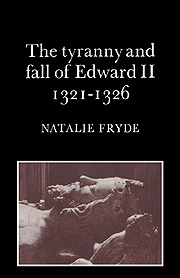Book contents
- Frontmatter
- Contents
- Preface
- Abbreviations
- 1 Problems and sources
- 2 Introduction: The king and the magnates before 1318
- 3 The rise of the Despensers
- 4 The civil war, 1321–2
- 5 The aftermath of the civil war: Imprisonments and executions
- 6 The aftermath of the civil war: Confiscations and the territorial settlement
- 7 Royal finance, 1321–6
- 8 The Despensers' spoils of power, 1321–6
- 9 The defeat in Scotland, 1322–3
- 10 The French war
- 11 The opposition to royal tyranny, 1322–6
- 12 London
- 13 Queen Isabella's invasion and the end of the regime
- 14 Edward II's deposition and ultimate fate
- 15 Epilogue: The regime of Mortimer and Isabella
- Appendix 1 Properties of the Despensers: Main facts and sources
- Appendix 2 The deposition of Edward II
- Notes
- Cited classes of records at the Public Record Office
- Sources
- Bibliography
- Index
Appendix 1 - Properties of the Despensers: Main facts and sources
Published online by Cambridge University Press: 09 October 2009
- Frontmatter
- Contents
- Preface
- Abbreviations
- 1 Problems and sources
- 2 Introduction: The king and the magnates before 1318
- 3 The rise of the Despensers
- 4 The civil war, 1321–2
- 5 The aftermath of the civil war: Imprisonments and executions
- 6 The aftermath of the civil war: Confiscations and the territorial settlement
- 7 Royal finance, 1321–6
- 8 The Despensers' spoils of power, 1321–6
- 9 The defeat in Scotland, 1322–3
- 10 The French war
- 11 The opposition to royal tyranny, 1322–6
- 12 London
- 13 Queen Isabella's invasion and the end of the regime
- 14 Edward II's deposition and ultimate fate
- 15 Epilogue: The regime of Mortimer and Isabella
- Appendix 1 Properties of the Despensers: Main facts and sources
- Appendix 2 The deposition of Edward II
- Notes
- Cited classes of records at the Public Record Office
- Sources
- Bibliography
- Index
Summary
This appendix is not intended as a detailed list of the properties of the two Despensers. Materials for drawing up such a comprehensive list do not exist. Because of gaps in evidence, notably for many of the immense Welsh properties of the younger Despenser, such a list would be of very uneven quality. No cartulary of Despenser properties exists. The evidence about the titles of the Despensers to their various properties and the approximate dates of their acquisition is therefore very uneven, though it can be satisfactorily reconstructed in many cases.
The private archives of the two Despensers, Hugh the Elder, earl of Winchester (Hugh I), and of his son, Hugh II, were seized by the crown in 1326 and remained permanently confiscated so that they still mostly survive. Summaries of their charters and other muniments were drawn up for the use of exchequer officials. Inquiries were held into the value of their English estates and into the goods found on them. The results of these inquiries were conveniently summarised in a single document of ten membranes (Exch.Anc.Extents, E. 142/33). For the vast majority of their English estates we have estimates of their value in 1326 and lists of movable goods kept on each separate estate before these properties were ravaged during the civil war in September–October 1326. It is also often known at what precise date each property has been acquired by the two Despensers and from whom.
- Type
- Chapter
- Information
- The Tyranny and Fall of Edward II 1321–1326 , pp. 228 - 232Publisher: Cambridge University PressPrint publication year: 1979



